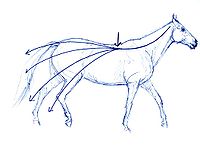
On the bit
Encyclopedia

Equestrianism
Equestrianism more often known as riding, horseback riding or horse riding refers to the skill of riding, driving, or vaulting with horses...
terms used to describe a horse's posture relative to the reins and the bridle
Bridle
A bridle is a piece of equipment used to direct a horse. As defined in the Oxford English Dictionary, the "bridle" includes both the headstall that holds a bit that goes in the mouth of a horse, and the reins that are attached to the bit....
bit
Bit (horse)
A bit is a type of horse tack used in equestrian activities, usually made of metal or a synthetic material, and is placed in the mouth of a horse or other equid and assists a rider in communicating with the animal. It rests on the bars of the mouth in an interdental region where there are no teeth...
. A position on the bit is submissive to the rider's rein aids
Riding aids
Riding aids are the cues a rider gives to a horse to communicate what they want the animal to do. Riding aids are broken into the natural aids and the artificial aids.-Natural aids:...
, given through the bit. When a horse is behind the bit, the head is tucked too far down and rearward. If above the bit, then the head is too high.
Technique
Being on the bit requires the horse to engage the hips and raise the back, which it cannot do when its head is pulled rearward. The neck is connected to the shoulders, and impeding the shoulders prevents extension of the forehand. This will cause the horse to hollow its back.A horse is properly placed, on the bit, by creating impulsion
Impulsion
Impulsion is the pushing power of a horse, which comes from its desire to move powerfully forward with energy. However, speed does not create impulsion, and a rushing horse is more likely to be "flat" than impulsive...
(pushing power) from the rider's driving aids
Riding aids
Riding aids are the cues a rider gives to a horse to communicate what they want the animal to do. Riding aids are broken into the natural aids and the artificial aids.-Natural aids:...
, and then containing this forward energy in the hands, via the reins and bit. Impulsion causes the horse to engage its hind end, lift its back, and finally (when it becomes submissive and accepts contact with the bit, without resistance) results in the horse flexing at the poll
Poll (horse)
The poll is a name of the part of an animal's head, alternatively referencing a point immediately behind or right between the ears. This area of the anatomy is of particular significance for the horse....
, maintaining an elastic contact that is equal on both sides of the bit. The horse stretches over its topline and follows the bit's contact forward and down. Being "on the bit" is more than just a fancy head position; seesawing on the bit causes tension throughout the body. On the bit is synonymous with "on the aids", where the horse is relaxed, using its back and hindquarters, and is responsive to the aids without tension.
As a test, the rider can soften contact, and the horse will maintain the pressure and follow the bit downward. The horse does not have to have its head perfectly perpendicular to the ground; it is acceptable, in dressage
Dressage
Dressage is a competitive equestrian sport, defined by the International Equestrian Federation as "the highest expression of horse training." Competitions are held at all levels from amateur to the World Equestrian Games...
tests, to have the nose slightly in front of the vertical.
Common faults


A horse that is on its forehand or unbalanced will not be able to come correctly on the bit, and will usually either lean on the rider's hands, placing too much pressure on the bit, pull against the rider and "root" or else brace upward against rein pressure and come "above the bit". This makes the contact heavy, and the aids can not come "through
Throughness
Throughness is a term used in equestrianism to denote an absence of resistance in the horse to the rider's commands.A 'through' horse is perfectly submissive, allowing the rider’s aids to go freely through the animal, with the reins influencing the forehand, and the riders' seat and legs...
."
Some horses will avoid contact with the bit, rather than correctly accepting it, and come "behind the bit". This may occur either due to evasion by the horse (so it does not have to listen to the rider) or because the rider is using the bit too strongly or physically trying to pull the horse on the bit. It is a very common fault if the rider "see-saws" on the reins.
Sometimes the horse will have a very strong contact, most commonly if its head is purposefully pulled in by the rider. Additionally, the horse will bring its nose closer to his chest, or "behind the vertical."
The most important test is if the horse will follow the contact forward, and down, if the reins are softened by the rider. If the horse follows, it is so to speak the horse that chooses to touch the rider with its mouth. If this quality of contact is established, the horse is really working on the bit, even if its head is a little in front of or behind the vertical.
Uses
Horses are required to go on the bit in certain riding disciplines, such as dressageDressage
Dressage is a competitive equestrian sport, defined by the International Equestrian Federation as "the highest expression of horse training." Competitions are held at all levels from amateur to the World Equestrian Games...
. However, all horses ridden on contact are generally encouraged to go on the bit, as this not only makes them more responsive to the rider's aids, but also allows them to move in a more athletic manner since the animal is raising its back and bringing its hocks further under its body.

